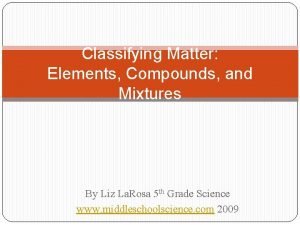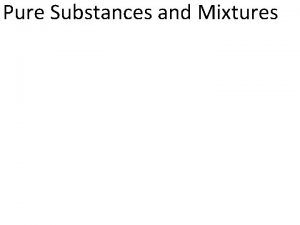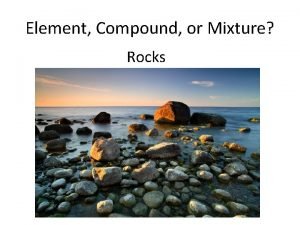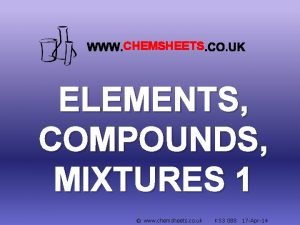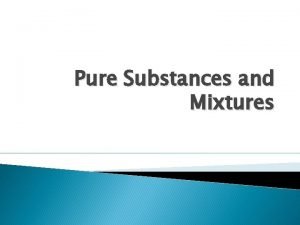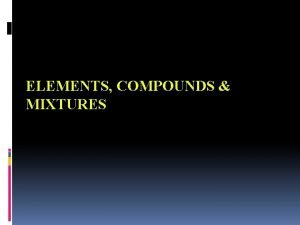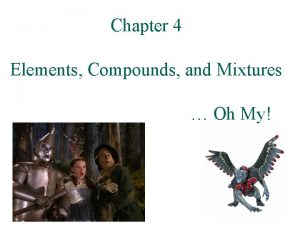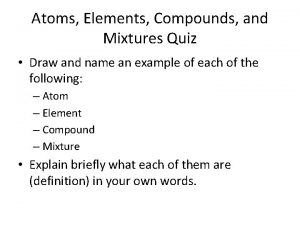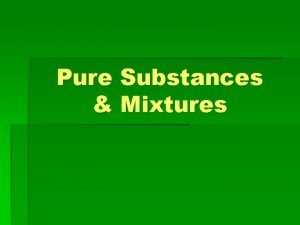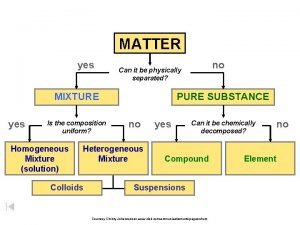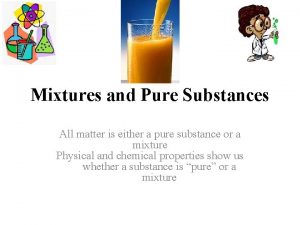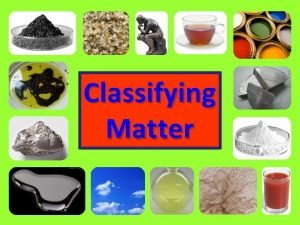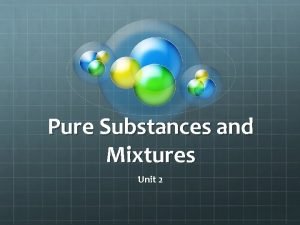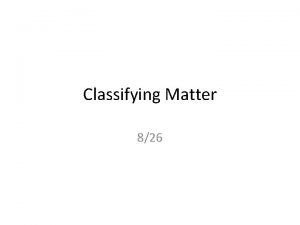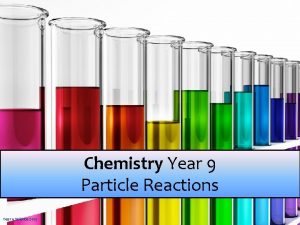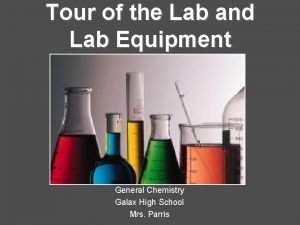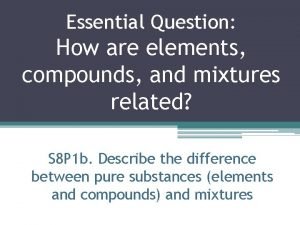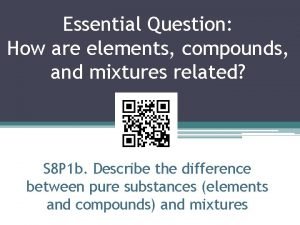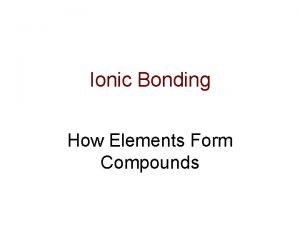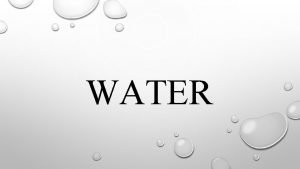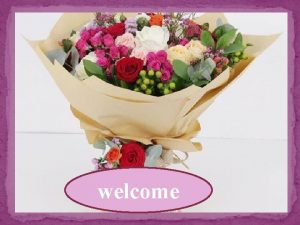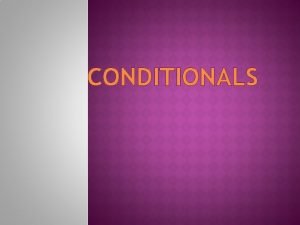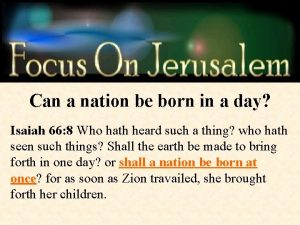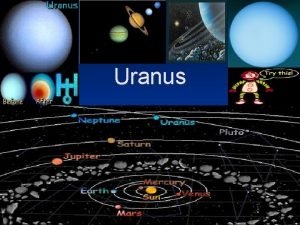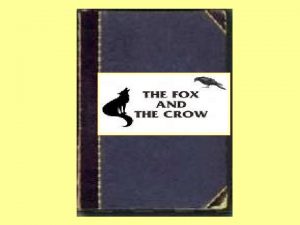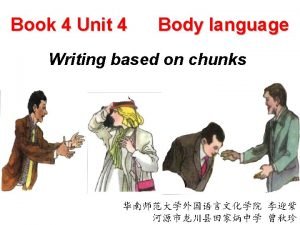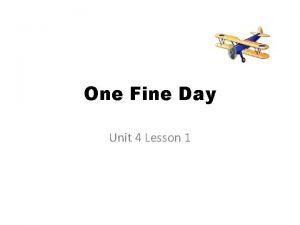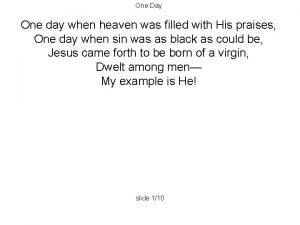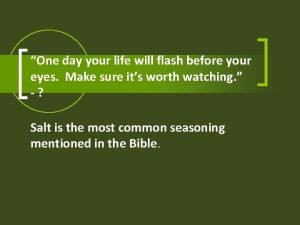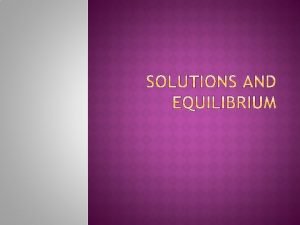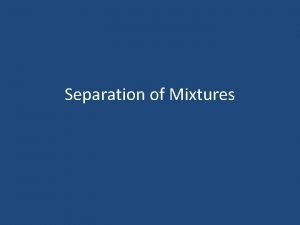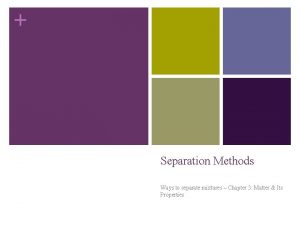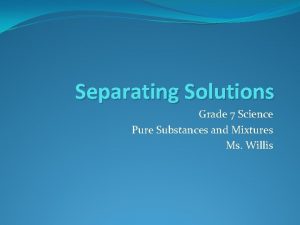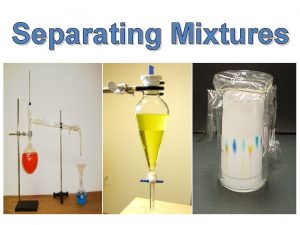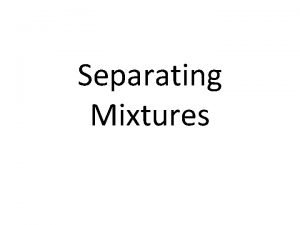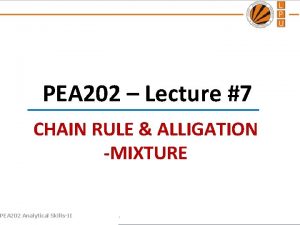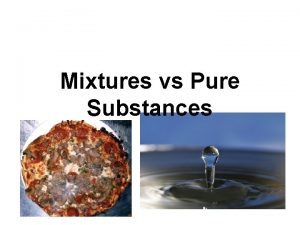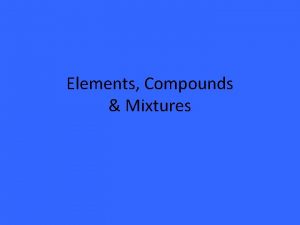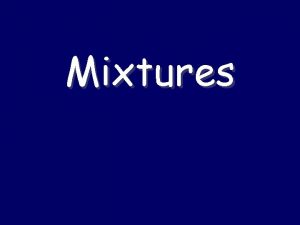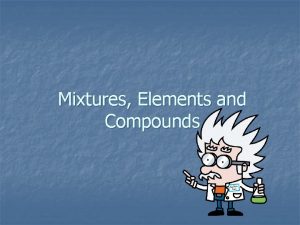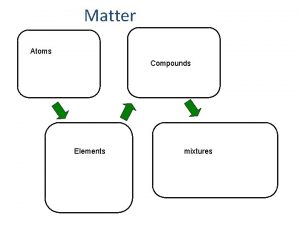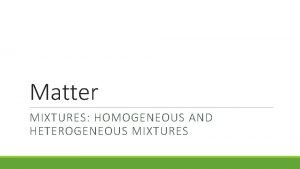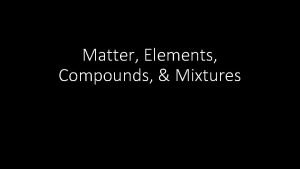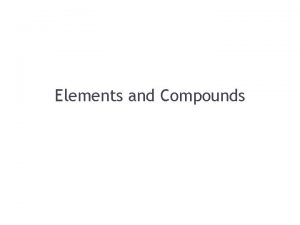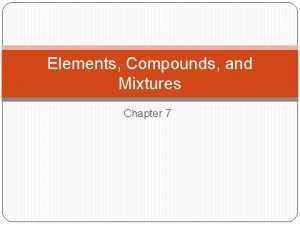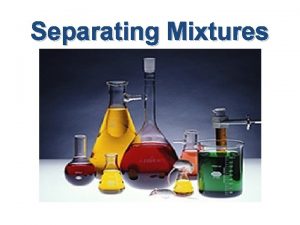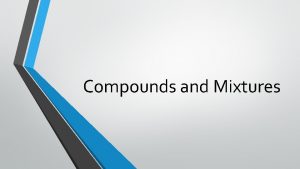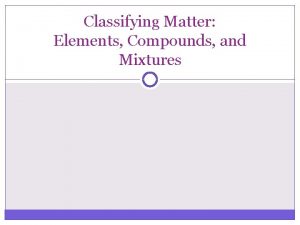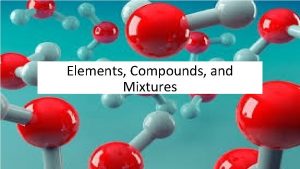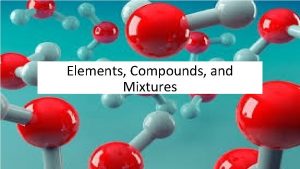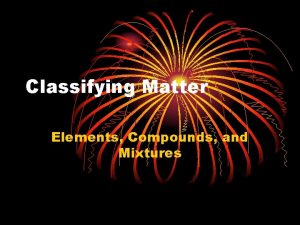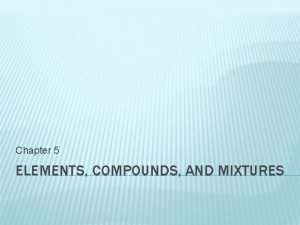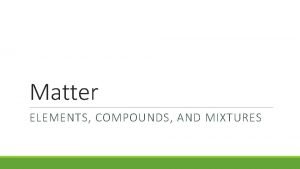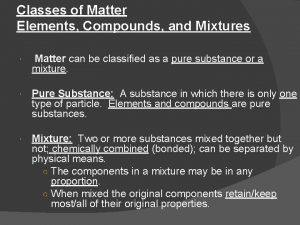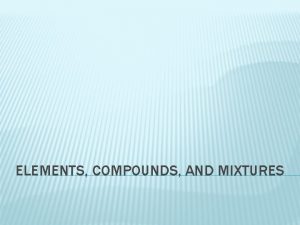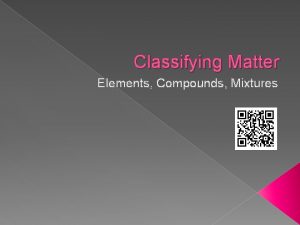MATTER Elements Compounds Mixtures DAY ONE EQ What





























































































- Slides: 93

MATTER Elements, Compounds & Mixtures DAY ONE

• EQ: What are solutions, colloids, and suspension? TIWL: about solutions, colloids, and suspensions, because they are all mixtures. JOURNAL WRITING (DIRECTIONS) • • • ANSWER WRITING PROMPT PLACE IN JOURNAL SECTION STUDENTS WILL SHARE RESPONSES (QUESTION) Define a mixture in your own words & draw 2 examples (examples: salad, trail mix etc. ) Students can refer to the textbook if needed.

Content STANDARD & ELEMENT STANDARD Element (b) S 8 P 2 : Students will examine the scientific view of the nature of matter. describe the difference between pure substances (elements and compounds) and mixtures.

Language of the Standards (Today's Vocabulary) Elements Compounds Mixtures Solutions Colloids Suspension Mixtures Physical Change Chemical Change

ESSENTIAL QUESTION 1. What are mixtures (solutions, colloids and suspensions? 2. How do we differentiate between elements, compounds & mixtures?

WHY IS THIS IMPORTANT ? TODAY I WILL ……. learn how to differentiate between SOLUTIONS, COLLOIDS & SUSPENSIONS. THIS IS IMPORTANT BECAUSE. . . because they are all MIXTURES.

ACTIVATOR DIRECTIONS : 1) LISTEN TO THE “SMASH-SONG/ VIDEO” from Glee Club 1) IDENTIFY THE MIXTURE OF SONGS

MIXTURES The Learning Period

• Elements • All elements are made of atoms. • Atoms of the same element are alike. • Atoms of different elements are different.

• Compounds are also pure substances. • But compounds are made from more than one element. • Water is a compound. • Water can be broken down into simpler substances – hydrogen and oxygen. •

• A mixture is a combination of two or more substances where there is no chemical combination or reaction. www. brainybetty. com 11

• Mixtures combine physically in no specific proportions. They just mix. www. brainybetty. com 12

Mixtures are classified as: HOMOGENOUS/HETEROGENO US SOLUTIONS COLLOIDS SUSPENSIONS www. brainybetty. com 13

COLLOIDS

• Colloids In a colloid the particles are mixed together but not dissolved. • The particles are relatively large and are kept permanently suspended. •

• Colloids A colloid will not separate upon standing. • The particles are constantly colliding, and this allows a colloid to scatter light – thus colloids often seem cloudy. •

Heterogeneous Mixtures (cont. ) Colloids are heterogeneous mixtures of intermediate sized particles (between 1 nm and 1000 nm) and do not settle out. Colloids are categorized according to the phases of their particles.



Heterogeneous Mixtures (cont. ) • Section 14 -1

SOLUTIONS

• Solutions A solution is a type of homogeneous mixture formed when one substance dissolves in another. • It is the best mixed of all mixtures. • A solution always has a substance that is dissolved and a substance that does the dissolving. • The substance that is dissolved is the solute and the substance that does the dissolving is the solvent. •

• Ocean water is a solution

• The universal solvent: Water

• Water as a solvent • Many liquid solutions contain water as the solvent. • Ocean water is basically a water solution that contains many salts. • Body fluids are also water solutions.

• Types of solutions Solute Solvent Example Gas Gas Liquid Solid Liquid Air (oxygen in nitrogen) Soda water (carbon dioxide in water) Ocean water (salt in water) Solid Gold jewelry (copper in gold)

• Air is a solution of oxygen and other gases dissolved in nitrogen


Homogeneous Mixtures (cont. ) • Section 14 -1

SUSPENSIONS

Suspension - a heterogeneous mixture in which the particles are large enough to be seen by a microscope or the unaided eye (eventually, they settle out of the mixture). Example: stirring a teaspoon of dirt in a glass of water.

CLASSWORK Directions: create a Triple Venn Diagram, or 3 Column Tchart to learn about the new vocabulary words. Each circle/chart needs to have 3 keys points, and 2 examples. • Solutions • Colloids • Suspension • Mixtures • Elements • Compounds

TRIPLE VENN DIAGRAM ELEMENTS COMPOUNDS MIXTURES

3 COLUMN T-CHART ELEMENTS COMPOUNDS MIXTURES

Closing USE A POST-IT & PLACE ON THE SPECIFIED GRAPHIC ORGANIZER Share some examples of your mixtures out loud with a partner and then with the class.

HOMEWORK REMINDERS ………. STUDY FOR THE QUIZ !!!!! STUDY ALL NOTES INCLUDING YOUR STUDY GUIDE!

MATTER Elements, Compounds & The Periodic Table DAY TWO

SPONGE DIRECTIONS: 1) ANSWER THE QUESTION 2) REVIEW THE STUDY GUIDE BEFORE THE QUIZ S 8 P 1 b. 1. If. different kinds of atoms are represented by different colored dots, which picture below represents a mixture? a. b. c. d.

2. Which of the following is a compound ? a. Oxygen b. Carbon c. Water d. None of the above 3. How many atoms are in CO 2 ? a. 1 b. 2 c. 3 d. 4

Content STANDARD & ELEMENT STANDARD Element (b) S 8 P 2 : Students will examine the scientific view of the nature of matter. describe the difference between pure substances (elements and compounds) and mixtures.

Language of the Standards (Today's Vocabulary) Elements Compounds Mixtures Solutions Colloids Suspension Mixtures Physical Change Chemical Change

ESSENTIAL QUESTION 1. What are mixtures (solutions, colloids and suspensions? 2. How do we differentiate between elements, compounds & mixtures? 3. How do I assess what I have mastered from the nature of matter unit?

WHY IS THIS IMPORTANT ? TODAY I WILL ……. assess what I have learned about matter. THIS IS IMPORTANT BECAUSE. . . it is important for me understand what standards I have mastered.

ACTIVATOR

WE ARE TESTING !!!!!

SOCRATIC SEMINAR Directions: WE will participate in a Socratic seminar over the article. This is a dialogue discussion. Students will get a ticket. Their ticket is their way into the conversation. Students must keep the conversation advanced.

Closing Today I felt about the quiz…… Use the subatomic particle faces to describe what you feel your performance on the quiz was:

Name: Elliott Electron Description: Negative Favorite Activity: Racing around the arcade

Name: Patty Proton Description: Positive Favorite Activity: Hanging out at the Nucleus Arcade Name: Nelda Neutron Description: Neutral Favorite Activity: Hanging out at the Nucleus Arcade

HOMEWORK REVIEW WHAT WE HAVE LEARNED TODAY

MATTER Elements, Compounds & The Periodic Table DAY THREE

SPONGE DIRECTIONS: Categorize (Elements and Compounds) by using a T-chart or Venn Diagram (1) AIR 0 HN (2) GOLD (3) Au BAKING SODA (5) (7) SILVER Ag (8) WATER H 20 (SODIUM BICARBONATE) Na. HCO 3 (4) SALT (SODIUM CHLORIDE) Na. Cl (6) PLATINUM Pt ACETONE (PROPANONE) C 3 H 6 O (9) OXYGEN O

EXAMPLES T-CHART & VENN DIAGRAM T-CHART Elements Compounds VENN DIAGRAM

Content STANDARD & ELEMENT STANDARD Element (b) S 8 P 2 : Students will examine the scientific view of the nature of matter. describe the difference between pure substances (elements and compounds) and mixtures.

Language of the Standards (Today's Vocabulary) Elements Compounds Mixtures Solutions Colloids Suspension Mixtures Physical Change Chemical Change

ESSENTIAL QUESTION 1. What are mixtures (solutions, colloids and suspensions? 2. How do we differentiate between elements, compounds & mixtures?

WHY IS THIS IMPORTANT ? TODAY I WILL ……. Complete an oil spill lab THIS IS IMPORTANT BECAUSE. . . because it will help me relate the concept of MIXTURES to real life.

ACTIVATOR: WATCH THIS !!! 1. WATCH OIL SPILL CLIP……DISCUSS http: //www. juliantrubin. com/fairprojects/environment/oilspill s. html


ACTIVATOR: WATCH THIS !!! 1. WATCH OIL SPILL CLIP……DISCUSS

• ATOMIC & MOLECULAR COMPOSITION Courtesy www. lab-initio. com

Closing QUESTION: List one thing that you learned about oil spills

HOMEWORK Complete your writing of the Oil Spill lab tonight…. .

MATTER Elements, Compounds & The Periodic Table DAY FOUR

SPONGE JOURNAL WRITING (DIRECTIONS) • • • ANSWER WRITING PROMPT PLACE IN JOURNAL SECTION STUDENTS WILL SHARE RESPONSES (QUESTION) Reflecting back on yesterdays lab. Why did the detergent work? .

Content STANDARD & ELEMENT STANDARD Element (b) S 8 P 2 : Students will examine the scientific view of the nature of matter. describe the difference between pure substances (elements and compounds) and mixtures.

Language of the Standards (Today's Vocabulary) Elements Compounds Mixtures Solutions Colloids Suspension Mixtures Physical Change Chemical Change

ESSENTIAL QUESTION 1. How do we differentiate between homogenous, elements, compounds & mixtures?

WHY IS THIS IMPORTANT ? TODAY I WILL ……. learn how to differentiate between heterogeneous & homogenous MIXTURES. THIS IS IMPORTANT BECAUSE. . . because MIXTURES are uniform and can be visually seen.

ACTIVATOR MAKE A PREDICTION…. . WHAT DO YOU THINK THE DIFFERENCES BETWEEN HOMOGENOUS & HETEROGENOUS MIXTURES ARE ?

• Is it uniform throughout? • If the answer is no, the matter is a heterogeneous mixture. Considered the “least mixed. ” • Does not appear to be the same throughout. • Particles are large enough to be seen and to be separated from the mixture. •

• Examples of heterogeneous mixtures • Sand pebbles • Oil and water • Powdered iron and powdered sulfur

• Examples of heterogeneous mixtures • Sand pebbles • Oil and water • Powdered iron and powdered sulfur

• Is it uniform throughout? • If the answer is yes, the matter is homogeneous (looks the same throughout). • That leads us to another question.

• Homogeneous Mixtures • A mixture that appears to be the same throughout. • It is “well mixed. ” • The particles that make up the mixture are very small and not easily recognizable.

• Examples of homogeneous mixtures Milk, toothpaste, and mayonnaise are homogeneous mixtures. They are also colloids.

Closing Illustrate !!!! Create a picture of your own examples of heterogeneous and homogeneous mixtures.

HOMEWORK Complete the worksheet. (Due Friday)

MATTER Elements &The Periodic Table DAY FIVE

SPONGE QUESTION: CREATE A LIST OF AT LEAST 5 THINGS THAT YOU THINK ARE PHYSICAL AND/OR CHEMICAL CHANGES. WHAT ITEMS CAN CHANGE PHYSICALLY ?

Content STANDARD & ELEMENT STANDARD Element (b) S 8 P 2 : Students will examine the scientific view of the nature of matter. describe the difference between pure substances (elements and compounds) and mixtures.

Language of the Standards (Today's Vocabulary) Elements Compounds Mixtures Solutions Colloids Suspension Mixtures Physical Change Chemical Change

ESSENTIAL QUESTION 1. What is the difference between physical & chemical changes ?

WHY IS THIS IMPORTANT ? TODAY I WILL ……. learn how to differentiate between physical & chemical changes. THIS IS IMPORTANT BECAUSE. . . because it is important to understand how matter changes.

ACTIVATOR WHAT HAPPENED TO THE MILK ?


Mixtures, elements, compounds • Scientists like to classify things. • One way that scientists classify matter is by its composition. • Ultimately, all matter can be classified as mixtures, elements and compounds.

By asking these questions scientists can classify matter into: • Mixtures – two or more substances that are not chemically combined with each other and can be separated by physical means. The substances in a mixture retain their individual properties. • Solutions – a special kind of mixture where one substance dissolves in another. Elements – simplest form of pure substance. They cannot be broken into anything else by physical or chemical means. • Compounds – pure substances that are the unions of two or more elements. They can be broken into simpler substances by chemical means. •

• Elements • All elements are made of atoms. • Atoms of the same element are alike. • Atoms of different elements are different.

• Elements • In 1813, a system of representing elements with symbols was introduced. • • Each symbol consists of one or two letters. Two letters are needed for a chemical symbol when the first letter of that element’s name has already been used.

• Compounds are also pure substances. • But compounds are made from more than one element. • Water is a compound. • Water can be broken down into simpler substances – hydrogen and oxygen. •

Closing COMPARE & CONTRAST : ELEMENTS, COMPOUNDS &MIXTURES ELEMENTS COMPOUNDS MIXTURES

HOMEWORK NO HOMEWORK…. . ENJOY YOUR WEEKEND !!!!
 Types of matter elements compounds and mixtures
Types of matter elements compounds and mixtures Day 1 day 2 day 3 day 4
Day 1 day 2 day 3 day 4 Elements, compounds and mixtures worksheet answer
Elements, compounds and mixtures worksheet answer Pure substances and mixtures worksheet answers
Pure substances and mixtures worksheet answers Rocks element compound or mixture
Rocks element compound or mixture Difference between mixture and compund
Difference between mixture and compund Chemsheets
Chemsheets Mixture matter graphic organizer
Mixture matter graphic organizer Types of homogeneous mixture
Types of homogeneous mixture Elements compounds and mixtures oh my
Elements compounds and mixtures oh my Elements compounds and mixtures quiz
Elements compounds and mixtures quiz Day one day one noodle ss2
Day one day one noodle ss2 Dayone dayone ss2
Dayone dayone ss2 Is sugar a pure substance
Is sugar a pure substance Composition uniform
Composition uniform Compounds vs mixtures
Compounds vs mixtures Day 1 day 2 day 817
Day 1 day 2 day 817 Is nail polish an element compound or mixture
Is nail polish an element compound or mixture How can matter be classified
How can matter be classified Metallic bond facts
Metallic bond facts Oh glorious day
Oh glorious day Section 1 composition of matter
Section 1 composition of matter Meysam golmohammadi
Meysam golmohammadi Section 1 composition of matter
Section 1 composition of matter Chapter 2 matter section 1 classifying matter answer key
Chapter 2 matter section 1 classifying matter answer key Arbor vitae
Arbor vitae Classification of matter section 1 composition of matter
Classification of matter section 1 composition of matter Gray matter and white matter
Gray matter and white matter Matter
Matter Energy naturally flows from warmer matter to cooler matter
Energy naturally flows from warmer matter to cooler matter One god one empire one emperor
One god one empire one emperor One one one little dogs run
One one one little dogs run One king one law one faith
One king one law one faith One empire one god one emperor
One empire one god one emperor One team one plan one goal
One team one plan one goal See one do one teach one
See one do one teach one See one, do one, teach one
See one, do one, teach one Night structure
Night structure Studiendekanat uni bonn
Studiendekanat uni bonn One vision one identity one community
One vision one identity one community Asean one vision one identity one community
Asean one vision one identity one community Honey homogeneous or heterogeneous
Honey homogeneous or heterogeneous Atoms elements molecules and compounds worksheet
Atoms elements molecules and compounds worksheet Is a bag of m&ms a mixture or pure substance
Is a bag of m&ms a mixture or pure substance Elements and compounds examples
Elements and compounds examples Chemistry in biology section 2 chemical reactions
Chemistry in biology section 2 chemical reactions Chapter 6 section 1 atoms elements and compounds
Chapter 6 section 1 atoms elements and compounds Used for holding hot objects especially crucible and cover
Used for holding hot objects especially crucible and cover Solution
Solution Elements combine to form
Elements combine to form Elements and compounds study jams
Elements and compounds study jams Chapter 6 section 1 atoms elements and compounds
Chapter 6 section 1 atoms elements and compounds Aluminum ionic bond
Aluminum ionic bond What is the most abundant compound on earth
What is the most abundant compound on earth Schoolmax login
Schoolmax login Oceans apart day after
Oceans apart day after Day to day maintenance
Day to day maintenance As your room gets messier day by day, entropy is
As your room gets messier day by day, entropy is Tomorrow i dont know
Tomorrow i dont know Romeo and juliet script
Romeo and juliet script Growing day by day
Growing day by day Seed germination inhibitors examples
Seed germination inhibitors examples Seed germination conclusion
Seed germination conclusion Role of transpiration
Role of transpiration I live for jesus day after day
I live for jesus day after day One day joynal looked for work
One day joynal looked for work One day closer quotes
One day closer quotes Perhaps one day a millionaire will ask you to marry him her
Perhaps one day a millionaire will ask you to marry him her This way that way over the irish sea
This way that way over the irish sea Can a nation be born in a day nkjv
Can a nation be born in a day nkjv 17th hour of the day
17th hour of the day Chapter one christmas day
Chapter one christmas day I got up early one morning and rushed into the day
I got up early one morning and rushed into the day One day can change your whole life
One day can change your whole life One day a crow was very thirsty
One day a crow was very thirsty One day later
One day later One fine day meaning
One fine day meaning One day when heaven was filled with his praises
One day when heaven was filled with his praises One day in hong kong
One day in hong kong One day butterfly
One day butterfly One day when heaven
One day when heaven One day your life will flash
One day your life will flash Circle the odd words
Circle the odd words Are all solutions homogeneous mixtures
Are all solutions homogeneous mixtures How can mixtures be separated
How can mixtures be separated Homogeneous mixture
Homogeneous mixture Separating mixtures grade 7
Separating mixtures grade 7 Filtration used to separate
Filtration used to separate Evaporation of mixtures
Evaporation of mixtures Examples of magnetism in separating mixtures
Examples of magnetism in separating mixtures Can sulfur and water be separated by filtration
Can sulfur and water be separated by filtration Allegation method
Allegation method Properties of materials grade 7 powerpoint
Properties of materials grade 7 powerpoint Pure substance pictures
Pure substance pictures
